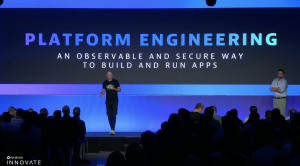Closed-loop remediation is an IT operations process that detects issues or incidents, takes corrective actions, and verifies that the remediation action was successful. Ideally, this all occurs without human intervention.
“Closed loop” refers to the continuous feedback loop in which the system takes actions — based on monitoring and analysis — and verifies the results to ensure complete problem remediation. Closed-loop remediation is vital to effective and reliable incident management because it ensures that organizations can consistently monitor any issue until it’s fully resolved.
How closed-loop remediation works
Closed-loop remediation uses a multi-step process that goes beyond simple problem remediation. This process identifies issues, notifies teams, and verifies solution efficacy continuously until it can confirm that the original incident is remediated.
Closed-loop remediation comprises the following stages:
- Stage 1: Triage
- Observability: First, an observability platform detects an issue by analyzing all the telemetry data from across multicloud environments and determining incident severity.
- Ownership: Next, the platform must determine the teams or individuals responsible for managing the incident and assign ownership to them.
- Ticket creation: Using the ticketing tool of choice, the platform creates a ticket outlining the problem details and the incident’s impact.
- Targeted notification: Responsible parties are automatically notified that an incident has occurred.
- Stage 2: Remediate
- Root cause analysis: The observability platform should be able to pinpoint the incident’s root cause.
- Automated response: Root cause identification triggers remediation workflows automatically based on the type of incident. Or, to take it one step further, the platform integrates with a tool such as Ansible to trigger remediation runbooks.
- Deployment: Once the platform has determined the most viable solution, it triggers deployment into the environment. The goal is to either improve or restore the system to its optimally functioning state.
- Stage 3: Validate
- Observability: After solution deployment, the observability platform scans the environment to determine its efficacy in resolving the issue. If the problem is fully remediated, the platform validates the solution to be effective and resolves the ticket.
- Closing the loop (or not): In the event of a successful solution, the platform informs the appropriate teams and closes the loop. If the solution is unsuccessful, the platform notifies the relevant teams of the persisting issue. The cycle restarts and further escalation ensues until arrival at a successful solution.
Benefits of closed-loop remediation
Beyond significantly reducing mean time to detect and mean time to resolution (MTTR), closed-loop remediation offers significant benefits, including the following:
Improved incident backlogs. Incident backlogs collect data on and record all unresolved issues. Closed loop remediation compiles important holistic data into incident backlogs, enabling teams to prioritize, monitor, organize, and analyze issues at scale. These capabilities improve resource allocation and communication among teams, breaking silos.
Improved change failure and escalation rates. Change failure rate represents the proportion of system changes that have failed to meet their intended objectives. It is also a key metric for organizations looking to improve their DevOps performance. Through the automated verification within closed-loop remediation, teams can easily determine their own change failure rate. The verification process provides teams with information regarding which kinds of system modifications are most effective, improving change failure rate over the long run.
The same concept holds true for incident escalation rate. This metric represents the proportion of system incidents resolved by escalating to a higher level of support. By continuously monitoring and verifying closed-loop remediation, teams can expect to reduce both their change failure and incident escalation rates.
Greater developer productivity. Developers often spend excessive time finding and managing solutions to incidents that arise within production environments. This time could be better spent innovating; closed–loop remediation frees up developers’ time, resources, and energy. It also facilitates workflow optimization by automating responses to specific events that trigger predefined remediation actions. Since this automation largely removes manual intervention, developers have greater bandwidth for innovation.
Auto-remediation examples
The following examples illustrate how closed-loop remediation works and its benefits.
Example #1: Stabilizing streaming load times
Consider a movie streaming application that experiences performance degradation, resulting in slow load times. The observability platform detects the anomaly and determines the root cause of the problem: increased traffic during peak usage hours, resulting in a server overload. The platform automatically creates an incident ticket that details the severity and potential impact of the issue and sends the ticket to the relevant teams. The system automatically triggers a remediation workflow that provisions additional resources to meet increased capacity requirements. After the scaling action, the platform validates the action’s efficacy by analyzing performance metrics to ensure that load times are back to normal. If successful, the system closes the loop and notifies teams. If the issue persists, it notifies the responsible teams who may need to do additional triaging to address the incident. Either way, the system updates the ticket to reflect the status of the issue.
Example #2: Prioritizing and remediating application vulnerabilities
An organization has an application that accesses confidential customer information. The organization’s observability and security platform identifies several vulnerabilities that have the potential to allow bad actors to access and leak proprietary information. However, only some of these vulnerabilities are exploitable; others are of lesser importance. The organization’s observability and security platform triages the numerous vulnerabilities and determines which ones to prioritize based on runtime context, such as adjacency to the internet or data sources. The system automatically generates tickets for critical vulnerabilities with all relevant information and assigns them to the responsible team for remediation.
Once fixes have been implemented and deployed, the platform scans for vulnerabilities once more and determines whether the vulnerabilities are still present. If the relevant vulnerabilities have been eliminated, then the fixes are validated: the system closes the loop and updates the ticket. If the platform determines that the vulnerabilities have not been eliminated, it updates the tickets to initiate further investigation. The process repeats it implements until an effective solution.
Example #3: Kafka disk resizing
A banking company has a Kafka event streaming broker whose disk usage is nearing critical levels, threatening potential disruptions or service degradation. The observability platform detects this issue as disk usage meets a predefined threshold and determines the root cause to be low disk space. Upon detection, the platform triggers an automated alert. The system executes an automated remediation workflow that dynamically adjusts the disk size by adding space or redistributing partitions. On completing these actions, the observability platform confirms that the remediation effort was successful, closes the loop, and notifies teams. If not, the platform restarts the process so teams can explore other remediation options.
To complete the cycle, platforms must be strong enough to accurately verify that remediation actions are indeed fulfilling their intended purposes. It is best practice to trigger actions to notification tools that indicate the success or failure of the remediation action.
Implementing closed-loop remediation with unified observability
At the foundation of any closed-loop remediation practice is a unified approach to observability that can fully monitor end-to-end DevOps processes. Moreover, an observability platform that harnesses AI for root-cause analysis will greatly expedite the entire remediation process, as it can quickly and intelligently determine the source of an issue without human intervention. Likewise, the observability platform can then notify the right teams and trigger automated workflows to take the appropriate remediation action.
Closed-loop remediation reduces MTTR and helps ensure a smooth, reliable customer experience. Dynatrace helps organizations realize these benefits through its unified platform that drives and optimizes auto-remediation. AutomationEngine enables DevOps teams to automate custom remediation workflows facilitated by continuous, real-time insights and precise answers. To validate the efficacy of such workflows on DevOps SLOs, Site Reliability Guardian (SRG) provides automated change impact analysis for new software versions. As such, SRG plays a crucial role in “closing the loop” of remediation workflows. SRG offers specific validation results against custom-defined SLOs for software updates across various systems. The result: teams can make more informed release decisions.
Equipped with these tools, along with unified observability, AI-driven analysis, and automation technology, Dynatrace offers all the elements necessary to optimize your closed-loop remediation practice.





Looking for answers?
Start a new discussion or ask for help in our Q&A forum.
Go to forum